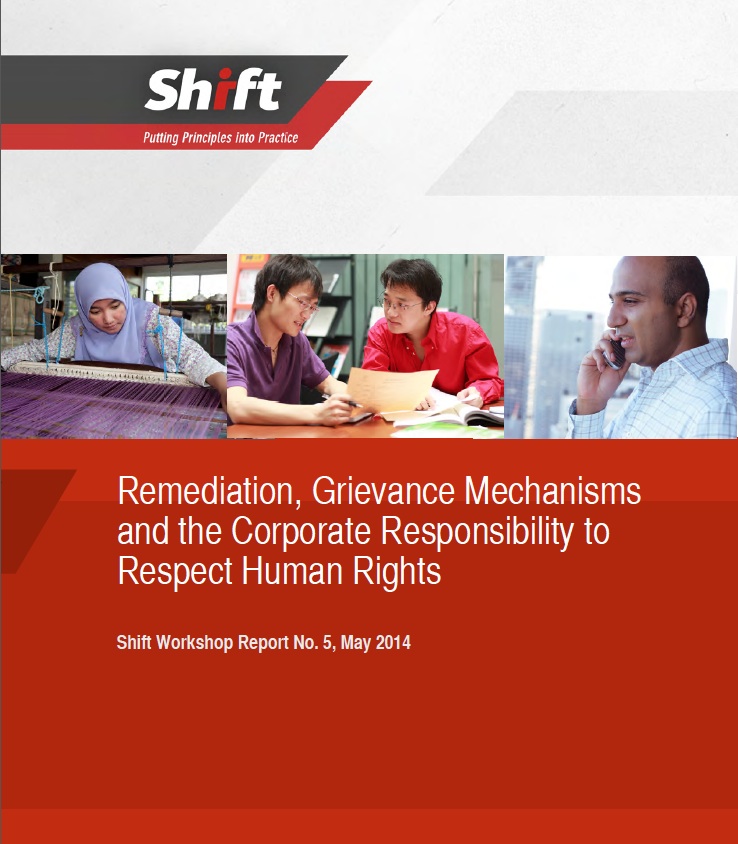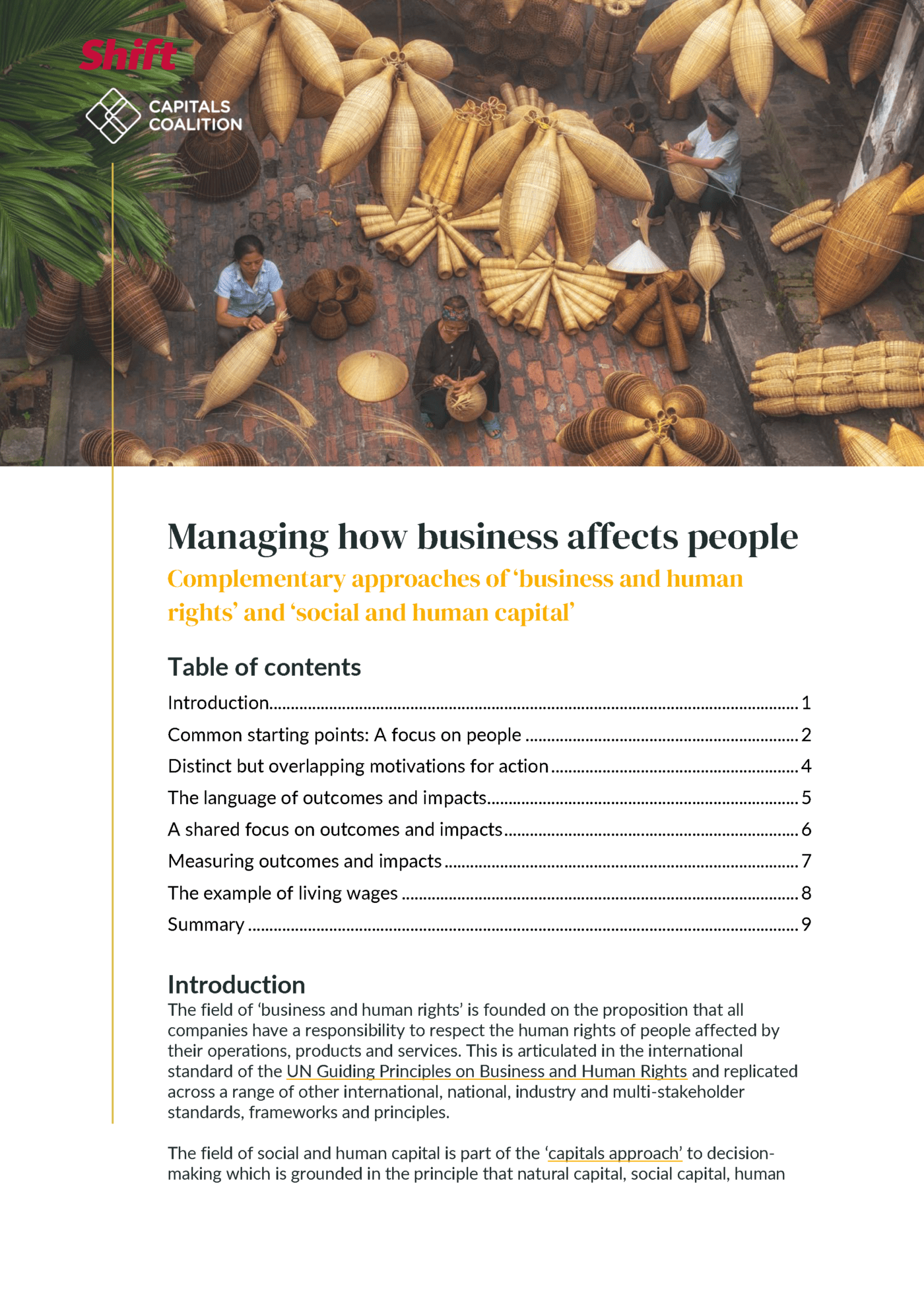Summary
In the Guiding Principles, the term remediation is used to refer to the process or act of providing remedy. It should not be confused with “remediation” in the context of social audits, where the concept includes (and typically focuses on) forward-looking actions to prevent a non-compliance from recurring.
At its core, the concept of remedy aims to restore individuals or groups that have been harmed – in this case by a business’s activities – to the situation they would have been in had the impact not occurred. Where this is not possible, it can involve compensation or other forms of remedy.
As the Guiding Principles set out, “remedy” in the judicial context is understood to include: “apologies, restitution, rehabilitation, financial or non-financial compensation, and punitive sanctions (whether criminal or administrative, such as fines), as well the prevention of harm through, for example, injunctions or guarantees of non-repetition.” These forms of remedy are relevant – or have equivalents in the case of punitive actions – also in the context of non-judicial mechanisms, with the exception of criminal sanctions.
Understanding the Business Responsibility for Remedy
The Guiding Principles make clear that a company’s responsibility to provide for remedy depends upon its connection to the human rights impact that has occurred: “Where business enterprises identify that they have caused or contributed to adverse impacts, they should provide for or cooperate in their remediation through legitimate processes,” (Guiding Principle 22).
Where the company has neither caused nor contributed to an impact, but the impact is nevertheless linked directly to its operations, products or services, there is no responsibility under the Guiding Principles to provide for or contribute to a remedy. A company may choose to contribute to remedy in these situations for other reasons – humanitarian, commercial, reputational or other – but this is not grounded in their responsibility to respect human rights.
Understanding and assessing the nature of a company’s responsibility with respect to a specific impact can therefore be an important step in determining a company’s responsibility to provide remedy. Few companies have systematic approaches for analyzing the nature of their responsibility. One company representative observed that, “Our incident management systems are primarily designed to see if an impact occurred, but we have no systematic way of analyzing what our role with the impact may have been.”
Mapping the Place of a Grievance Mechanism
Where companies have caused or contributed to an impact, they have a responsibility to provide or contribute to remedy for those who have been harmed. Primarily, the way companies have understood this responsibility is the need to establish grievance mechanisms, through which affected stakeholders can raise and seek redress for impacts that have occurred.
The internal “ecosystem” for remediation
Internal policies and processes that may already exist and provide a channel for receiving complaints and/or for addressing them include:
- Whistle-blower / ethics hotlines
- Employee ombudsman / human resources complaints processes
- Open Door / Speak up policies
- Trade Unions / Industrial Relations processes
- Consumer complaints mechanisms
- Community facing grievance mechanisms
- Business-to-Business contract clauses with dispute resolution provisions
- Code of Conduct requirements for supplier mechanisms
- Audit processes (and worker interviews)
- Supply chain hotlines
- Stakeholder engagement (at the site level and the policy level)
Mapping the internal ecosystem for remediation serves a number of purposes:
- Increasing internal comfort with the concept
- Identifying gaps
- Learning from existing processes
- Ensuring connectivity: impacts and grievances are channeled to the right people to be addresses, and the business has full visibility into its human rights impacts.
The external “landscape” for remediation
Just as companies can look at the internal ecosystem as they consider strengthening or augmenting existing remediation processes, they can likewise look at the “external landscape” for remediation in different operational contexts.
States have critical roles to play in ensuring that effective judicial and non-judicial processes are present. They do so through national court systems and statutory and regulatory bodies, such as national human rights institutions, labor dispute bodies, as well as through administrative mechanisms such the National Contact Points (NCPs) of the OECD Guidelines for Multinational Enterprises. Public financial institutions and multi-stakeholder initiatives may also provide accountability mechanisms and grievance processes to enable those affected by their clients’ or members’ business activities to raise concerns and seek redress for impacts.
Operational-level grievance mechanisms administered or co-administered by companies sit within this landscape – as non-state-based, non-judicial mechanisms, which should be primarily dialogue based in nature.
Operational-Level Grievance Mechanisms
Operational-level grievance mechanisms are a systematic means of providing remediation processes.
This resource does not seek to provide full treatment of how to make operational-level mechanisms effective. However, some key areas to keep in mind include:
- Need for effective management system of the grievance mechanism
- Determining scope for the grievance mechanism
- Considering how to talk about the grievance mechanism
- Designing the system with an holistic and integrated, rather than silo’ed, approach
- Ensuring an escalation process
- Using the effectiveness criteria (set out in the Guiding Principles)
- Connecting grievance mechanisms with stakeholder engagement
- Getting started by knowing where you currently are
Roles and Responsibilities for Remedy in the Value Chain
When impacts occur within a company’s value chain, businesses often find themselves in a “linkage” situation: that is, the company has not caused or contributed to the impact, but the impact is directly linked to the company’s operations products or services.
In such circumstances, businesses should first confirm that it is indeed a situation of linkage, and not contribution. For instance, in the supply chain context, companies can in some instances contribute to impacts that occur at the supplier level, for example, through their purchasing practices or payment terms.
In these circumstances, companies can play an important role in incentivizing those in their value chain to provide effective grievance mechanisms. This is likely to be easier in relation to suppliers than in downstream relationships.
Ways companies incentivize suppliers to establish grievance mechanisms may include:
- Making expectations of grievance mechanisms clear in contracts or codes of conduct;
- Including review of grievance mechanisms during assessments;
- Offering capacity building for suppliers on grievance mechanisms;
- Providing a recourse mechanism (like a hotline) if local grievance mechanisms are inadequate.




